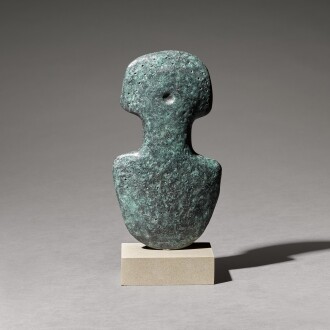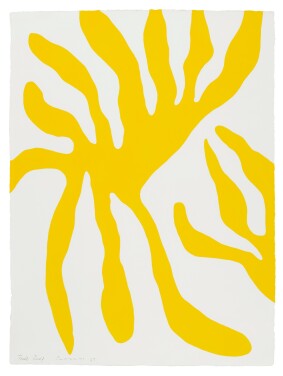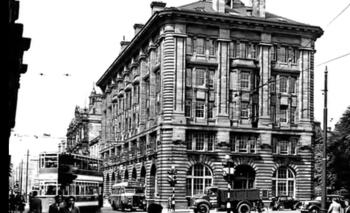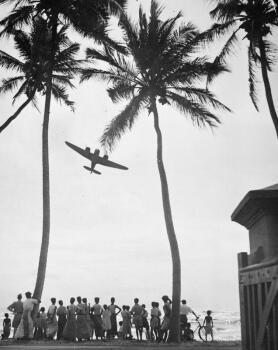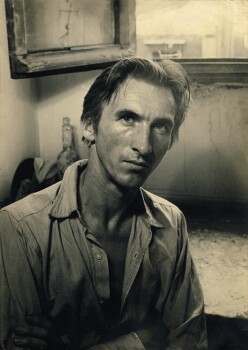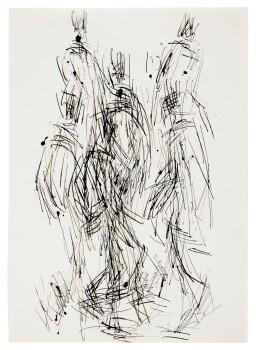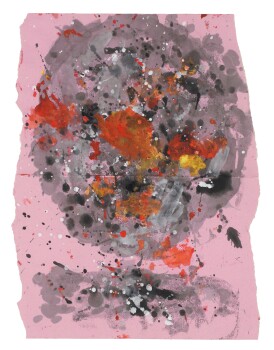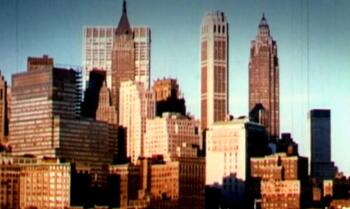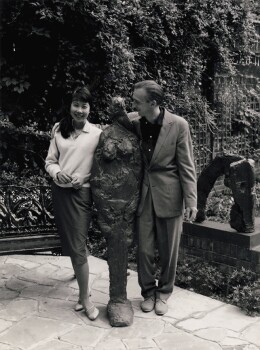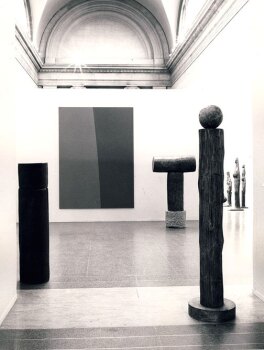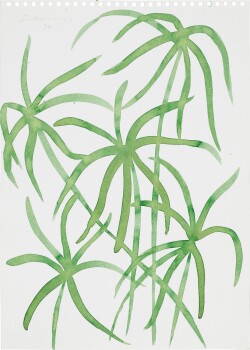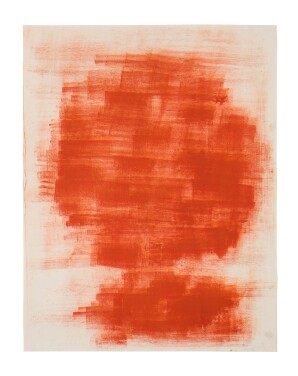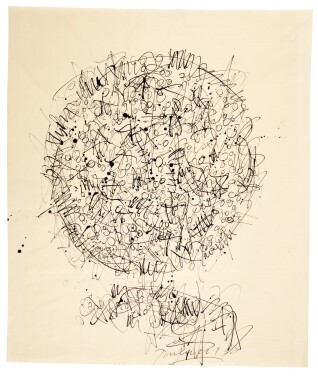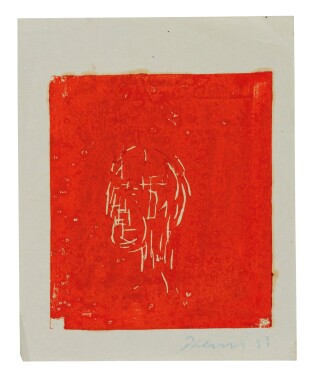
William Turnbull was one of the most talented artists of his generation. Although best known as a sculptor, painting and drawing were fundamental to his artistic practice. This group of work sourced directly from the Artist’s Estate demonstrates the extraordinary breadth of his creative output and traces his development from rarely seen graphic work executed in the 1950s, through to paintings, drawings and prints from the 1970s, 1980s and 1990s alongside three signature sculptures.
Throughout his life, he was inspired by many different sources from pre-Columbian and non-Western objects, to aerial landscapes experienced during active service with the RAF during WWII, to contemporary industrial design. Combining ancient symbols with a modernist sensibility, his work is imbued with a sense of timelessness - a sense that an early critic described as ‘The Eternal Now’.
Featured Highlights
- 1922
- 1941
- 1946
- 1948
- 1950
- 1957
- 1960
- 1973
- 1982
- 1995
- 2013
-

DC Thomson building, Dundee Turnbull was born and grew up in Dundee, a town which was particularly hard hit by the depression in the 1930s and suffered mass unemployment. Turnbull had to leave school at 15 and was lucky to get a job at the magazine publishers DC Thomson. Many of his colleagues had attended art school and it was through them that he was introduced to modern European art – Cezanne and Monet became particularly important to him.
"That is where my art education began in a very lucky and uncomplicated way."
(William Turnbull in William Turnbull: Beyond Time, a film by Alex Turnbull and Peter Stern, 2013). -
 Digitised Leanne Rodgers-Gibbs (
Digitised Leanne Rodgers-Gibbs (Ceylon Under the Wing of the RAF (Photo: Dickson, CI 96, Imperial War Museum) Turnbull joined the RAF as a pilot, and flew on war service in Canada, India and Ceylon.
"When you are flying in an airplane and you are looking down at a landscape it is nothing like the kind of landscape as the one Constable was painting. Suddenly you look down and there is this endless abstraction and it was a new way of seeing the world that certainly made me have a totally different attitude to what was visually the reality."
(William Turnbull in William Turnbull: Beyond Time, a film by Alex Turnbull and Peter Stern, 2013). -

William Turnbull, circa 1945 Following the end of the War, Turnbull left the Air Force and pursued his ambition to become an artist, joining the painting department at the Slade School of Fine Art, London. He quickly transferred to the sculpture department where he met Eduardo Paolozzi and Richard Hamilton – later these three would form the Independent Group. -
 Turnbull moved to Paris having spent six weeks travelling in Italy. Paris was still considered the capital of the art world and revered masters such as Leger, Giacometti and Brancusi could all be approached in the cafes or found in their studios. These artists were to have a great influence on Turnbull’s work. "One of the very pleasant things about Paris after the war, I think it was a result of the war being finished, was that people were comparatively accessible, but the artist I sought that was most important to me was Alberto Giacometti whose work made an enormous impression on me at that time and I managed to meet him and visit him on a number of occasions during the time I was in Paris."
Turnbull moved to Paris having spent six weeks travelling in Italy. Paris was still considered the capital of the art world and revered masters such as Leger, Giacometti and Brancusi could all be approached in the cafes or found in their studios. These artists were to have a great influence on Turnbull’s work. "One of the very pleasant things about Paris after the war, I think it was a result of the war being finished, was that people were comparatively accessible, but the artist I sought that was most important to me was Alberto Giacometti whose work made an enormous impression on me at that time and I managed to meet him and visit him on a number of occasions during the time I was in Paris."
(William Turnbull in William Turnbull: Beyond Time, a film by Alex Turnbull and Peter Stern, 2013). -
 In 1950, Turnbull moved back to London and had his first show with Eduardo Paolozzi at the Hanover Gallery organized by David Sylvester. His first solo show followed in 1952, the same year that he was selected by Herbert Read to be included in the British Pavilion at the Venice Biennale. The show was an instant, international success, propelling Turnbull onto the international sculpture stage. At this time, Turnbull was interested in raw surface textures and spontaneous and gestural mark-making, with a focus on the figure in his graphic and sculptural work.
In 1950, Turnbull moved back to London and had his first show with Eduardo Paolozzi at the Hanover Gallery organized by David Sylvester. His first solo show followed in 1952, the same year that he was selected by Herbert Read to be included in the British Pavilion at the Venice Biennale. The show was an instant, international success, propelling Turnbull onto the international sculpture stage. At this time, Turnbull was interested in raw surface textures and spontaneous and gestural mark-making, with a focus on the figure in his graphic and sculptural work. -
 Turnbull visited New York for the first time, where he was introduced to Mark Rothko and Barnett Newman by the collector Donald Blinken who he first met in 1955. From this time, Turnbull abandoned figurative references in his paintings and produced powerful abstract compositions.
Turnbull visited New York for the first time, where he was introduced to Mark Rothko and Barnett Newman by the collector Donald Blinken who he first met in 1955. From this time, Turnbull abandoned figurative references in his paintings and produced powerful abstract compositions.
"What was going on in New York at that time was quite stunning"
(William Turnbull in William Turnbull: Beyond Time, a film by Alex Turnbull and Peter Stern, 2013). -

Kim Lim and William Turnbull In 1960, Turnbull married the sculptor and printmaker, Kim Lim. Between 1962 and 1963, they visited Japan, Cambodia, and Lim’s native Singapore. These travels were a great inspiration to Turnbull who would continue to regularly visit Japan and Singapore throughout his life. For example his Blade Venus series reference Japanese swords and Chinese chopping knives. -

William Turnbull, Tate, 1973 Turnbull had a major retrospective at the Tate Gallery, curated by Richard Morphet. On seeing all his work together, Turnbull began to move away from the more modular, steel sculptures he had been creating over the last decade and returned to the modeled, textured work of his early career.
"The real revelation for me was the big Tate show … you saw this extraordinary artist who was not only a sculptor but also a painter and whose ability to work in both mediums was really very profound ... to come in and see this blaze of colour and also this absolute control he manages to exert over the way he works was really extraordinary to me."
(Sir Nicholas Serota in William Turnbull: Beyond Time, a film by Alex Turnbull and Peter Stern, 2013). -

William Turnbull, Botanical Series 3, Singapore, Estimate £1,500–2,000 Joint exhibition with Kim Lim at the National Museum Art Gallery, Singapore. Turnbull’s visits to Lim’s native Singapore continued to be provide profound influences and his Botanical Series from the mid 1970s were directly inspired by the lush foliage he experienced there. -
 A major exhibition William Turnbull Sculpture and Paintings curated by David Sylvester opened at the Serpentine Gallery, London. This was accompanied by a key publication, the first devoted to the artist in over 20 years. The scale and number of paintings included alongside his sculpture was revelatory to many visitors.
A major exhibition William Turnbull Sculpture and Paintings curated by David Sylvester opened at the Serpentine Gallery, London. This was accompanied by a key publication, the first devoted to the artist in over 20 years. The scale and number of paintings included alongside his sculpture was revelatory to many visitors. -
 A major exhibition opened at Chatsworth House, Derbyshire, the year after Turnbull died. Works were selected from each period of his career incorporating all different scales shown within the more intimate galleries inside the house as well as outside, in the magnificent gardens.
A major exhibition opened at Chatsworth House, Derbyshire, the year after Turnbull died. Works were selected from each period of his career incorporating all different scales shown within the more intimate galleries inside the house as well as outside, in the magnificent gardens.
The Importance of Drawing
Drawing was a vital element of Turnbull’s creative practice. He did not make preliminary drawings and rarely created maquettes for sculptures and paintings and thus each drawing was an authoritative moment in his oeuvre rather than any means to an end.
Watch William Turnbull on The Importance of Drawing
In the early 1950s Turnbull discovered oriental philosophies and became particularly interested in the thought behind Zen painting where each brushstroke instantaneously communicated the artist’s idea without any pre-ordained compositional outcome. Turnbull’s series of calligraphic heads relate strongly to this influence, each stroke independent of the other and yet naturally synthesized to evoke a powerful human presence.


With thanks to Offer Waterman, London, who represent the Estate of William Turnbull and to Alex & Johnny Turnbull.
